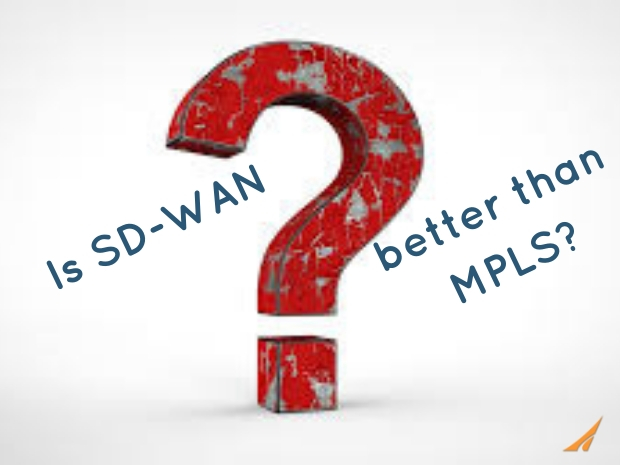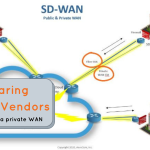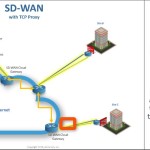As SD-WAN rapidly gains interest among IT decision makers like yourself, one of the most common questions continues to be: Is SD-WAN better than MPLS?
Depending on who’s asking, this question can mean a couple things; One of them being: Is SD-WAN going to save our company money?
Yes, SD-WAN is better than MPLS. Yes, it is going to save your company money… in the future, but probably not immediately, compared to what your company is paying today, for your current MPLS network.
Example:
“ABC Software” has an MPLS network. Their corporate headquarters has a 100M fiber MPLS connection, costing them $1,000/month. They also have a 1G fiber Dedicated Internet Access (DIA), circuit at HQ, (costing $2,000/month), which all locations share, for public Internet connectivity, via the MPLS network. All security, content filtering, etc. is handled centrally, at HQ. Their total cost for circuits at HQ (MPLS + Internet), is $3,000/month.
Each of ABC Software’s 20 remote sites has a 10M MPLS circuit, costing $600/month/site. Total cost of MPLS at remote sites is $12,000/month.
ABC Software’s total (current) cost for all MPLS and Internet circuits, is $15,000/month.
The company has benefited from the QoS their MPLS is providing for their on-site, real-time applications (i.e. voice, video, remote desktop, etc.), but ABC Software is realizing, (as they start to move some of their applications to the cloud), the remote sites need more public Internet bandwidth. Their IT team feels the 1G public Internet circuit (at HQ) is enough, but the remote sites are being suffocated by their small MPLS circuits. Their IT team also knows increasing MPLS bandwidth at the remote sites will also cause the 100M MPLS connection (at HQ), to bottle-neck if left at only 100M.
The IT team are savvy, IT Ninjas… so they are looking at all of their options: Either upgrading their MPLS bandwidth at HQ or moving to SD-WAN. Here are their options:
Option 1: Increase MPLS bandwidth at HQ
- 500M MPLS at HQ (upgrade): $2,000/month
- 20M MPLS at each remote site (upgrade): $700/month x 20 sites = $14,000/month
- 1G Public Internet Access at HQ (existing): $2,000/month
- Total Price: $18,000/month
Option 2: Transition to SD-WAN
- 1G DIA Public Internet Access at HQ (existing): $2,000/month
- 1G Broadband public Internet access at HQ (new): $400/month
- 300M x 20M (primary) Broadband public Internet access at each remote site (new): $250/month x 20 sites = $5,000/month
- Secondary 100Mx20M Broadband public Internet access at each remote site (new): $100/month x 20 sites = $2,000/month
- Cloud-Enabled SD-WAN with built-in UTM Firewall: $500/month at HQ; $250/month/remote site. Total cost for SD-WAN = $4,400
- Total Price $14,900/month
As you can see, moving to SD-WAN is going to be approx. the same price as ABC Software’s current MPLS costs. It will, however, bring significant savings (approx. $3k/month), to their future bottom line, when compared with upgrading their MPLS bandwidth.
In addition to future savings, SD-WAN will give their company the following benefits over MPLS:
- Less downtime by adding more redundancy for both WAN and Internet traffic, since they now have two large connections failing to one another, at each site.
- Significantly more bandwidth than MPLS at HQ. Now they will have 2G of combined, load-balanced bandwidth, at HQ,
- Significantly more bandwidth for remote sites. By decentralizing security and moving to a managed, cloud firewall (where content filtering and security monitored and administered through a centralized portal), all remote sites now access Internet directly through less expensive (and much faster), broadband Internet connections, with 40x the download speed at each remote site.
- Better network visibility. Their SD-WAN solution will allow them to monitor all circuits and network traffic, by application.
- Better security: The new firewall is state-of-the-art, and their IT team no longer has to spend hours of time on updates, checking logs, etc. Furthermore, all security decision-making is happening in the cloud (as opposed to on-site), preventing unwanted traffic from bogging down their Internet bandwidth.
- Better cloud performance: Their SD-WAN solution performs forward error correction, jitter buffering, and cloud session reassignment, which significantly improves all cloud application performance for employees at all sites.
Can you see why I know SD-WAN is better than MPLS, for most companies?
It’s probably not going to lower your company’s current bills, but it will bring a lot more future savings and value, as your company moves more applications to the cloud and needs to increase bandwidth, and improve site-to-cloud QoS.
Questions? Need SD-WAN quotes? Email or call me at 877-465-3505.
Want to browse SD-WAN providers, by feature, service area and more? Use our, SD-WAN Provider-Finder.
About the Author
Mike Smith is the Founder and President of AeroCom and has been helping companies with telecom and cloud services since 1999. He has been the recipient of numerous business telecommunications industry awards and in 2011, he was honored as one of the top 40 business people in Orange County, CA., under 40 years old. Follow Mike on LinkedIn, Twitter or SpiceWorks.



![Is SD-WAN better than MPLS? Price [Video]](https://www.aerocominc.com/info/wp-content/uploads/2018/10/Is-SD-WAN-better-than-MPLS-Thumb-150x150.jpg)



